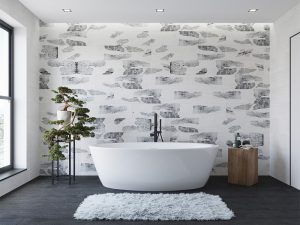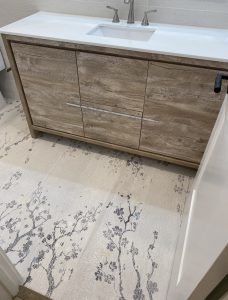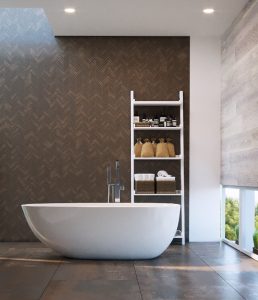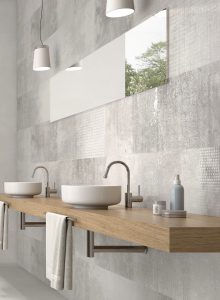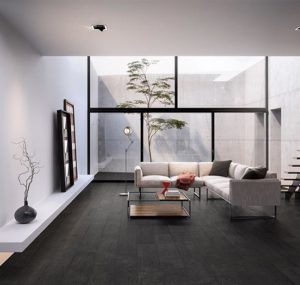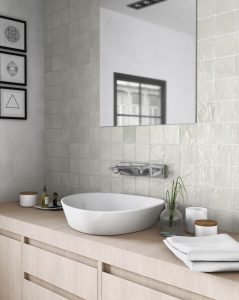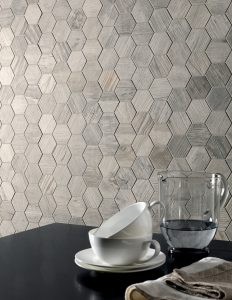Your Complete Guide to Japandi Interiors With Tiles
A luxurious example of Japandi interiors inside a contemporary, stylish master bathroom. Using a pattern feature wall tile (Kasai Carta Koi) behind the bathroom’s bath tub, the space is given character and charm without being maximalist in nature.
Japandi interiors are taking the interior design world by storm, and for us, it’s something to be excited about. After all, the true beauty of this design lays in its simplicity, balance and laid back approach…What’s not to love about that?! Today we’re talking all things Japandi interiors; from what the concept is, how to style it, and ways to use tile in a space to achieve it. Scroll on and get yourself a dose of design inspo!
What are Japandi interiors?
A gorgeous floral floor tile (Kasai Carta Sakura) crafts a unique Japanese inspired design on the flooring in this residential home’s bathroom. It’s a perfect display of a Japandi interior; balanced, calming and soothing.
What do you get when you fuse together the beloved Scandi interior design style with a more zen, Japanese treatment? Japandi interiors. The name, as it may imply, is the literal combination of “Japan” with “Scandi” to create “Japandi.” How does this work? Allow us to explain!
Basically, it’s taking the simplicity and organic elements that Japanese zen interiors are known for, and blending it with the beauty, and warmth of Scandi interior designs. Scandinavian design is known for its concept of “hygge” (comfort and cosiness) helps to compensate for this with a natural, pared-back aesthetic. The overall achievement for Japandi interiors, then, is delicate balance with contemporary style and minimalistic decor touches.
The simple lines of that comprise each design style fuses together to make a classic interior tile trend that is bound to take the design world by storm in 2022. This beautiful décor style can easily be brought into your client’s home or commercial décor, to create a sleek and elegant space.
What are the key elements that make up Japandi interiors?
Key Element 1: Function first
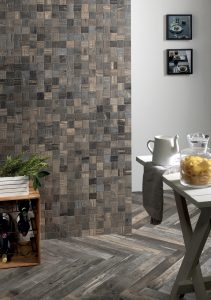
Everything has its place when it comes to designing for Japandi interiors, and that’s shown in this modern marvel of a kitchen. Using a natural wood look tile floor and pairing with a wood look porcelain tile on the wall, the result is a space that’s functional, and stylish.
Just as expected in any modern minimalist design style, the overarching concept in Japandi design is having each piece serve a specific function. You don’t want to have excess decor or colors in your final designed space, no. The true measurement of success in this design concept is how little you need to use to make the perfectly balanced space. So, yes, in a way designing with intention has been given a new name. 😉
Key Element 2: Organic shapes
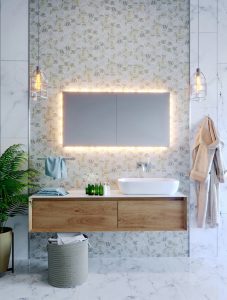
Pure perfection. Using a recycled glass hexagon tile with marble look (Tuckernuck Hex), this space not only nods to sustainability (a perk for Japandi!) but creates dimension in a most soothing way by way of a feature bathroom wall tile design.
The art of organic shapes is to keep things interesting, without overpowering the entire space. How to achieve this with Japandi interiors? Through using the correct form, pairing with function, and defining it with the right color palette. For example, using a multi tonal glass mosaic tile with a hexagon or herringbone shape, you can add depth, visual interest and maintain an organic shape element within the design. Thereby achieving your Japandi design goals with minimal risk to the trend.
Key Element 3: Natural neutrals
We spoke about the rise of neutral interiors shown at Cersaie tile show in Italy, and this carries through in the Japandi interiors style. Using neutral tiles in a Japanese Scandi chic space is the key to creating a lasting impact worthy of the new taste.
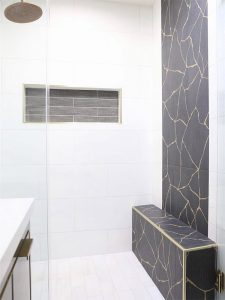
A trio of neutral tones come together to create a startlingly sophisticated yet beautiful design concept in this steam room by (Kasai Notte Kintsu). (photo: @dekorati18)
The color palette is comprised of nudes, beiges, sand, whites, blacks, grays and tans. The hues denote the overall tranquility that the space is meant to convey. Use black glass mosaic tiles on a shower wall paired with stone look shower floor tiles, for instance, or decorate a kitchen backsplash with creamy white subway wall tiles paired with dark wood floor tiles. The ideal achievement for Japandi is minimalistic, synchronistic style.
This contrast is meant to highlight a space’s functionality, add depth, and instill a sense of yin-and-yang to it. For the dark should be complemented by the light. This gives off the coziness of Scandi chic interiors with the Feng shui beloved of Japanese interiors.
Key Element 4: Less clutter
Clutter is the enemy of Japandi interiors and this spacious, beautiful master bathroom is proof as to why. The minimalistic approach to organization strips back the interior to include just the necessities a person would need, and in the end creates a truly unique space. The use of a pattern bathroom wall tile (Stellar Copper Herringbone) ties it all together to make it warm, interesting and modern.
If there ever was a case for “less is more”, it’s with Japandi interiors. This makes sense after all, the new interior style is the child to parent trends that are rooted in form, function and fashion. What would a space be if without a purpose? Or without carefully curated components to make a delightful design? The answer, well, isn’t something we want to know!
The key concept for this interior trend is to create a calm and clean look and to do this; it’s essential to stick to clean lines. It’s about stripping interiors back and thinking about functionality and simplicity. Don’t overcrowd your interior, keep it minimalistic and select pieces which truly speak your space’s personality.
Bringing in warm hues from wood look tiles and pairing with white subway tiles on walls is a great way to introduce simple lines in an interior that rings true to the Japandi interior trend.
Key Element 5: More natural lighting
A sleek, japandi bathroom interior that showcases the power of natural lighting. Using organic shapes, organic materials (wood), and a a shimmering white ceramic backsplash tile (Atlantis White Deco), it’s showcasing the appeal of playing with sunlight throughout a modern space.
When it comes to zen interiors, and scandi chic interiors, there’s something to be said about the element of natural light! It’s a must-have to welcome breathability into a space, and really hone in on the natural essence of it. While spacious rooms with wide windows will have an unfair advantage, don’t let that hold you back! You can still design a smaller space by working in large mirrors and reflective mirror tiles to create the illusion of more dimension and light. Win-win.
Why are Japandi Interiors so hot right now?
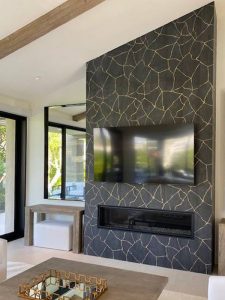
A transformative fireplace tile design in this residential home takes the trend to another level. It uses a kintsugi style black porcelain tile (Kasai Notte Kintsu) reminiscent of Japanese pottery, and makes a focal point that’s unforgettable.
You, like many others, may be wondering; Why are Japandi interior design styles so hot right now? Well, if we had to guess, it comes down to the changes that have occurred over the last two years, on a global scale. More people found themselves at home, working and living, which led to a need to create more functional living spaces. Not to mention, this exposed them to seeing the same cluttered rooms daily which definitely led to most reconsidering their way of living. The result? Wanting to create a less-is-more environment that’s both cozy, and stylish. This interior design style does just that while also adding in an element of contemporary appeal.
How to use tile in Japandi interiors
Floral tile floors (Kasai Carta Sakura) create an undeniable centerpiece in this guest bathroom. Using the cherry blossom tile on the bathroom floors, the designer (Emily Palm Tile) was able to achieve the sought after trend for her client.
Using tiles to create a Japandi interior design is as fun as it looks. There are so many different tiles that can be chosen to create the space of your client’s dreams, and it really just comes down to knowing what their preference is. Within Japandi interiors, you can add subtle pattern tiles to form a statement design, or stick to a more monochromatic tile design. There’s really no wrong way to do this, as long as you touch on all the key elements outlined in the above paragraphs. See? We meant it when we said it’s fun!
A startlingly dimensional living room with charcoal black porcelain floor tiles (Kasai Notte) that create depth and a curated design that embraces the yin-and-yang technique of Japandi.
Using darker color tiles like black tiles or brown wood look tiles is a way to create a space that’s a bit more moody than the polished, beige and white tone interiors associated with the design trend. This is a great way to achieve a more mature, flavorful design for your client. For example, adding a black porcelain floor tile with wood look to a living room serves two functions: 1) It adds the appearance of more space, which, let’s be honest, is desirable and 2) Hides any spills, stains or pet scratches. Take it from the above space, it’s a pretty stylish route to travel down.
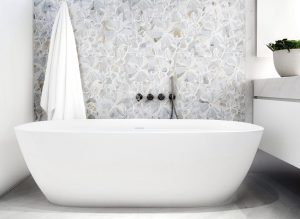
Gorgeous floral marble accent wall tile (Himiko) in master bathroom to create a sophisticated style in line with the latest 2021/22 tile trend.
On the flip side of dark tile is natural stone tile which can function seamlessly in a Japandi interior. Using a pattern marble tile means a space is elegantly elevated and given a chic sense of sophistication. Why? Marble tile is ubiquitous for being classy, timeless and ethereal. Same holds true in these more contemporary spaces. Take for instance the use of a Japanese inspired marble tile in this bathroom. Using this as a feature wall tile, the ensuite bathroom is not only gorgeous (truly a spectacle of artistry!) but nails the Far East feeling perfectly.
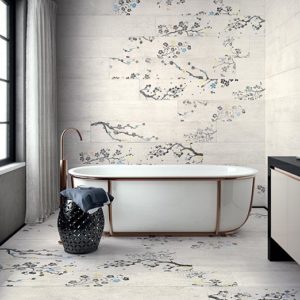
Japanese garden style bathroom design with a cherry blossom porcelain tile feature wall and matching floor tiles emboldening and captivating the room.
For a similar feeling, but in a more durable form, try porcelain tiles with a feminine floral pattern. These tiles will not only work to create an ethereal interior but last though-out the years. Case-in-point in the way this floor-to-ceiling tile bathroom uses a floral pattern porcelain tile to create a stand-out design. The pattern porcelain tile has a chic floral pattern that complements the wood look tile on the backsplash walls and brass fixtures in the bath rub perfectly. Clearly a case of modern-meets-marvelous done right for a Japandi style home.
To make the most of this trending style in your next design, considering making an impact with handmade look ceramic tiles (Silk Collection) like this stunning bathroom backsplash design did.
While we’re all for some fancy florals and deep, dark wood tiles, we’d be remiss not to show you how to use ceramic tiles in your Japandi interior. After all, a component of the design stems from wabi sabi, which favors the beauty of imperfections. For ceramic tiles, perfect imperfections is a way of being. A favorite in recent times are zellige ceramic tiles, which have a high gloss facade, wavy texture and unique shape. They are a great addition, as seen above, in any space that wants an effortlessly chic touch.
A dynamic hexagon wood look wall tile (tile shown unavailable, similar: Timbuktu) adorns a sleek, contemporary kitchen design where the designer effortlessly hit all the stops in the Japandi style book.
The final use of tile in Japandi spaces? Wood look tiles. Thanks to printing advancements, the intricate details of these tiles will trick the eyes into thinking the real thing is in sight. You can enjoy a large spectrum of wooden hues that are in line with a Japandi aesthetic think; oak, cedar, white-washed woods. Plus, there’s specific attention given to replicating a realistic wood graining and knotting to create a dimensional result. Use on kitchen floors, commercial lobby entryways, living room walls, and bathroom backsplashes for a simple twist!
There you have it; everything you have to know about Japandi Interiors in one place. Did you see any tiles you like for your Japandi interior? Feel free to sign up to be a dealer today and let us help you with your next tile project! Sign up here.


